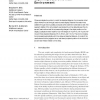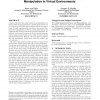PRESENCE
2002
14 years 2 months ago
2002
A set of rules is presented for the design of interfaces that allow virtual objects to be manipulated in 3D virtual environments (VEs). The rules differ from other interaction tec...
PRESENCE
2000
14 years 2 months ago
2000
Observers adjusted a pointer to match the depicted distance of a monocular virtual object viewed in a see-through, head-mounted display. Distance information was available through...
SIGOPS
2008
14 years 3 months ago
2008
What do our computer systems do all day? How do we make sure they continue doing it when failures occur? Traditional approaches to answering these questions often involve inband m...
VR
2000
IEEE
14 years 7 months ago
2000
IEEE
This paper proposes a novel ‘Visuo-Haptic Display’ using a Head-Mounted Projector (HMP) with X’tal Vision optics. Our goal is to develop the device which enables an observer...
DAGM
2001
Springer
14 years 7 months ago
2001
Springer
We describe an Augmented Reality system using the corners of a color cube for camera calibration. In the augmented image the cube is replaced by a computer generated virtual object...
ISMAR
2003
IEEE
14 years 8 months ago
2003
IEEE
In this paper, we describe the effects of shadow representation of virtual objects in Augmented Reality. Optical consistency is important in order to create realistic augmented re...
VRST
2005
ACM
14 years 8 months ago
2005
ACM
Many mixed-reality systems require real-time composition of virtual objects with real video. Such composition requires some description of the virtual and real scene geometries an...
VRST
2006
ACM
14 years 9 months ago
2006
ACM
Complex 3D interaction tasks require the manipulation of a large number of input parameters. Spatial input devices can be constructed such that their structure reflects the task ...
VR
2007
IEEE
14 years 9 months ago
2007
IEEE
In this paper, the effects of three visual factors: scene complexity, stereovision and motion parallax on correct perception of a virtual object’s size were analyzed in an immer...
HAPTICS
2008
IEEE
14 years 9 months ago
2008
IEEE
We propose a wearable haptic display that indicates the pressure and vibration on the palm for bimanual operations in virtual reality environments. This system aims to provide the ...


